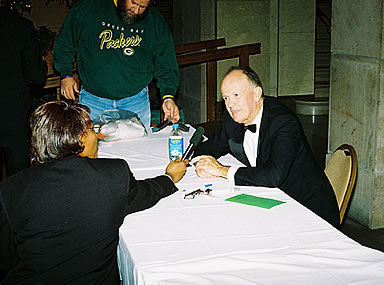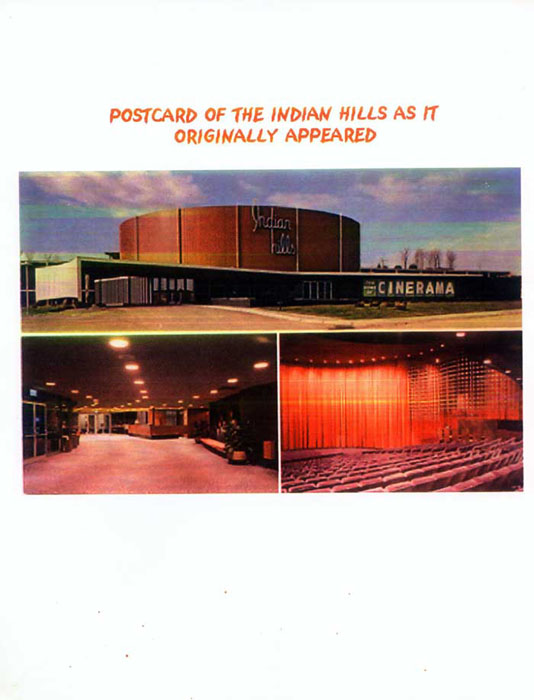General Discussion
Related: Editorials & Other Articles, Issue Forums, Alliance Forums, Region ForumsRay Bradbury home's demise has LA re-examining its history ("Something Wicked This Way Comes")
Last edited Sun Feb 22, 2015, 01:31 PM - Edit history (1)
http://hosted.ap.org/dynamic/stories/U/US_LAS_HISTORY_DEMOLISHED?SITE=AP&SECTION=HOME&TEMPLATE=DEFAULT

This Wednesday, Jan. 14, 2015, photo, shows a house being demolished that science fiction writer Ray Bradbury lived in, in the Cheviot Hills neighborhood of Los Angeles. It was the house where Bradbury wrote "Something Wicked This Way Comes," and when the bulldozer came to knock it down literary scholars and preservationists were aghast. The bright yellow home with the big bay windows where the author lived and worked for 54 years wasn't the first Los Angeles landmark to be flattened of course. The statuesque Ambassador Hotel, where Robert Kennedy was assassinated in 1968, is now the site of a public-school complex. (AP Photo/Nick Ut)
BY JOHN ROGERS
LOS ANGELES (AP) -- It was the house where Ray Bradbury wrote "Something Wicked This Way Comes," and when the bulldozer came to knock it down literary scholars and preservationists were aghast.
The bright yellow home with the big bay windows where the author lived and worked for 54 years wasn't the first Los Angeles landmark to be flattened of course. The statuesque Ambassador Hotel, where Robert Kennedy was assassinated in 1968, is now the site of a public-school complex.
Still, in a city where not much seems to last very long, the Bradbury home's destruction came as a surprise in part because the guy who knocked it down was one of the city's most prominent architects and Los Angeles is in the midst of what officials call the most far-reaching study of historical structures undertaken by any city.
When it is completed next year, SurveyLA will have catalogued all of the city's 880,000 buildings, giving planners a better idea of what's significant. "Increasingly, we are now able to know what and where our historic resources are," said Ken Bernstein, who manages the city's Office of Historic Resources.
FULL story at link.
Here I am in the Packer sweatshirt. Artist Harrison Ellenshaw did the art for Disney's "Something Wicked This Way Comes". He autographed a rare (unworn) promo shirt for the fim and several other Disney works of his like "TRON".

More here: http://www.omahafilmevent.com/past/marypoppins1.htm
Marta and I are not looking ahead to a "Something Wicked" remake at all: http://www.hollywoodreporter.com/heat-vision/disneys-something-wicked-way-comes-744908
OS
enlightenment
(8,830 posts)Destroyed to build some modernist cube that doesn't fit the character of the neighborhood and is undoubtedly too big for the lot. I've never liked Mayne's "vision" of architecture - fug ugly always springs to mind.
PasadenaTrudy
(3,998 posts)for many of us Angelenos....
SheilaT
(23,156 posts)books and stories he wrote, I'm just not one to get sentimental over what looks to have been an ordinary suburban tract home that he lived in.
JI7
(89,252 posts)SheilaT
(23,156 posts)What if a new owner painted it a different color, or extensively remodeled it?
There are an awful lot of writers out there who've written things many people have loved. While it's nice of things are preserved, it's not always sensible or practical.
I am not trying to start an argument, just fleshing out my different take on things.
ND-Dem
(4,571 posts)for 50 years, until his death. Not a mansion. To me that's very special.
https://www.redfin.com/CA/Los-Angeles/10265-Cheviot-Dr-90064/home/6795777
petronius
(26,602 posts)where it happened - this particular structure provides no insight into Bradbury's thought process, there's (as far as I know) no remaining trace of his life or workspace in the house, and it's not likely to become accessible other than as a view from the street.
It would be different if the house itself was his work-product, and important in it's own right, or if it did help understand how he worked. For instance, the home or studio of a painter, photographer, sculptor, writer, poet where the local environment was a formative influence.
It's far more important to preserve his words; it would have been great if his office as he left it could have been transferred to the library or a museum, and his papers should be preserved and accessible. But I'd much prefer to see the effort spent bringing Bradbury's books to the attention of Angelenos. Or if the house was to be preserved into a museum or place of study, that would be great. But there's very little value in just preserving the house as is...
(At some point, of course, we're going to need to preserve some of these 'old' California homes--the bungalows and mission revivals and ranch homes--just to keep that piece of our landscape history.)
Omaha Steve
(99,660 posts)http://www.nationalregisterofhistoricplaces.com/faq.html
Frequently Asked Questions
What are the Listing Criteria?
The National Register's standards for evaluating the significance of properties were developed to recognize the accomplishments of all peoples who have made a significant contribution to our country's history and heritage. The criteria are designed to guide State and local governments, Federal agencies, and others in evaluating potential entries in the National Register.
Criteria for Evaluation The quality of significance in American history, architecture, archeology, engineering, and culture is present in districts, sites, buildings, structures, and objects that possess integrity of location, design, setting, materials, workmanship, feeling, and association, and:
A. That are associated with events that have made a significant contribution to the broad patterns of our history; or
B. That are associated with the lives of persons significant in our past; or
C. That embody the distinctive characteristics of a type, period, or method of construction, or that represent the work of a master, or that possess high artistic values, or that represent a significant and distinguishable entity whose components may lack individual distinction; or
D. That have yielded or may be likely to yield, information important in prehistory or history.
The register would not have saved the home. A typical landmark designation would. Usually that designation prevents altering the exterior of the home or building.
One more week and the home would have been saved by the new local law.
I was the leader of a group that tried to save an architectural and historic theater in 2001: http://en.wikipedia.org/wiki/Indian_Hills_Theater
Indian Hills Theater Preservation Society
Following the "Newstime" announcements, the Indian Hills Theater Preservation Society was founded with the goal of preserving the theater. Leaders of the Society were Steve Dawes, Ron A. Hunter, Tom Hunter, Frank Merwald and Susie Rose. The Society was assisted by letters of support to the local newspaper from film industry members such as Kirk Douglas, Charlton Heston, Janet Leigh, Patricia Neal, Robert Wise, Richard D. Zanuck and Ray Bradbury.[1] Bruce A. Crawford was largely responsible for facilitating the involvement of the Hollywood industry. Additionally, film historian Leonard Maltin appeared in a public-service commercial that aired on local television and radio in support of the Society. However, the CEO of Nebraska Methodist, Stephen Long, refused to discuss any alternative to immediate demolition.
Omaha Landmarks Heritage Preservation Commission
On August 8, 2001, a hearing was held before the Omaha Landmarks Heritage Preservation Commission to determine whether the Indian Hills Theater should be designated an Omaha Landmark. Such a designation, upon confirmation by the Omaha City Council, would protect the theater from demolition. Presentations were made by the Indian Hills Theater Preservation Society and attorneys for Nebraska Methodist. Filmmaker and Cinerama historian David Strohmaier stated, in video testimony, that the Indian Hills was "the finest venue for wide-screen films in the world." The Commission voted unanimously to recommend to the Omaha City Council that the theater be designated a "Landmark of the City of Omaha."

haele
(12,660 posts)And fairly well crafted (his neighborhood was built for middle-class families) with architectural built-ins, on a decent sized lot.
The type of house, that when restored, attracts young professionals and improves the property value of the entire neighborhood.
Spend $70K in renovations and restorations to bring it both up to code and looking like it did when it was built, and you could easily sell it for $800K to $1million in that neighborhood.
Haele
SheilaT
(23,156 posts)Then one wonders just why it was torn down, rather than being redone.
But builders and developers do all sorts of irrational things all too often.
Omaha Steve
(99,660 posts)Multiple photos here: http://roryposin.com/property-details.php?property_ID=95
JUST SOLD! $1,765,000
10265 Cheviot Drive is perhaps Cheviot Hill's most important address. For more than half a century it was home to Ray Bradbury, one of the most celebrated, beloved authors of our time. This charming traditional features a grand living room with soaring vaulted ceilings, classic brick fireplace, large bay window allowing soft California light to flood in across original hardwood floors and custom built-ins; formal dining room for proper entertaining with detailed crown moldings, expertly crafted wainscoting and wood shuttered windows; 3 generously sized en-suite guest bedrooms; maid's quarters on the main floor; expansive grounds with a large front yard as well as backyard to retreat to the outdoors in a secluded environment and a surprisingly spacious basement where he chose to write daily. A beautiful property with an important cultural provenance, come see where so many great works of fiction were conceived. A tremendous opportunity to begin a new chapter in its storied history.
Ray Bradbury's home in Cheviot Hills up for sale, open house Sunday
By Kevin Roderick | May 17, 2014 1:29 PM

Front of Ray Bradbury home, photos by Byron Espinoza.
The Cheviot Drive home where Ray Bradbury lived and wrote for 50 years has been listed for sale at $1.495 million. It's your typical Cheviot Hills 4-bedroom, 3-bath with 2,400 square feet and a decent backyard. His writing room in the basement is billed as the place where Bradbury wrote his most famous works, including "Fahrenheit 451," "The Martian Chronicles" and others. That is, when he wasn't typing "Fahrenheit 451" on pay-by-the-minute typewriters in the UCLA Library.
Open house is Sunday 2-5 at 10265 Cheviot Drive. The listing.
Bradbury died on June 5, 2012

Back yard.
dilby
(2,273 posts)I mean if the guy built the house with his own hands then yeah that might be worth preserving. But he just ate, slept, worked and shit in that building, there are lots of other buildings he probably did most or all of the same exact things in, should those be preserved too?
Omaha Steve
(99,660 posts)One man's junk....
His later home would have been a great museum.
http://lit.newcity.com/2011/07/27/something-waukegan-this-way-comes-finding-ray-bradburys-boyhood-muse/
Literary Road Trips
Something Waukegan This Way Comes: Finding Ray Bradbury’s Boyhood Muse

Ray Bradbury's boyhood home
By Dan Kelly Chicago’s sci fi pedigree is impeccable. Edgar Rice Burroughs (creator of Tarzan and John Carter: Warlord of Mars) was born in the city and lived in Oak Park, for example, while Weird Tales magazine—publishers of H.P. Lovecraft, Robert E. Howard, Robert Bloch and others—had offices downtown. The real coup, however, is Waukegan, the setting for the birth, boyhood, and books of Ray Bradbury. A short trip to the town revealed that the writer of “Fahrenheit 451? is a prophet with honor, but minimal commemoration, in his hometown.
A Midwestern Proust, Bradbury re-imagined Waukegan as Green Town, Illinois, in several works—most famously in “Something Wicked This Way Comes” and “Dandelion Wine.” Per Bradbury, Waukegan was a charming rural burg of the twenties, rife with sun-dappled fields and pies cooling on windowsills, which happened to be visited by serial killers and evil carny demons. Waukegan may well have been sun-dappled, etc. when Mr. Bradbury was growing up, but today’s reality is grim. The Autumn People may have succeeded, leaving semi-industrial, depressed Waukegan—location of three superfund clean-up sites—in their wake. It’s not a happy place, though it’s obvious some people are trying to revive the poor thing.
FULL story at link.